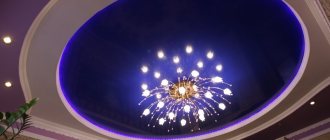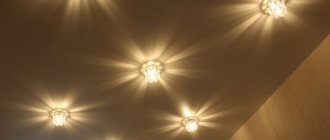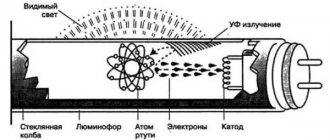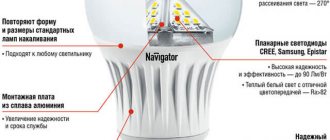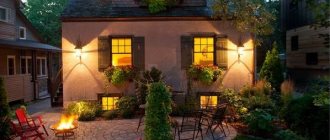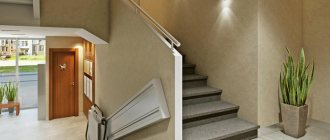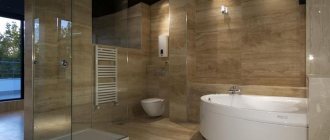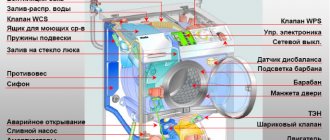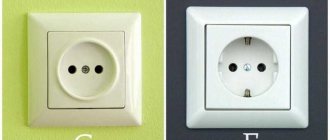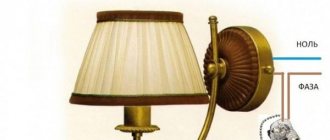Designs of lighting systems in modern residential premises most often involve the installation of spotlights in plasterboard.
Spotlights for plasterboard ceilings allow you to obtain high-quality general light or accentuated lighting of individual areas of the room.
The features of spotlights installed behind plasterboard sheets will be discussed in this article.
Types of spotlights
Lamps for plasterboard coatings are classified according to the following parameters:
- voltage level;
- type of lamps;
- design features.
From a performance point of view, these parameters are not critical, but they are important when it comes to design ideas, the purpose of the light and the number of bulbs required. Below we will look at the features of choosing a lamp according to the above parameters.
Voltage level
There are three types of devices on the market that operate at different voltage levels:
- 220V;
- 12V;
- 3V (we are talking about LED lighting devices, for which voltage is not a defining characteristic, since their operation is related to the current driver).
The level of voltage required directly depends on the type of light bulbs. You need to decide on the type of lighting device in advance, since the design of lamps for plasterboard ceilings is characterized by some features.
A transformer is used to reduce the voltage, and the driver already mentioned above is used to operate LED lighting devices.
Note! When replacing one type of lamp with another, it may be necessary to change the wiring diagram.
Lamp type
The following types of light bulbs are used for plasterboard ceilings:
- incandescent;
- luminescent;
- halogen;
- LED
Spotlights for plasterboard ceilings that work with conventional incandescent light bulbs do not require special devices for connecting them.
However, lamps with standard incandescent lamps have a number of disadvantages. The main one is the large size of the spotlights, since you will need a 7-8 centimeter gap between the drywall and the floor slab, and this will reduce the height of the ceiling.
In addition, incandescent lamps are prone to increased heating (especially if their power is higher than average), which will force you to take additional fire safety measures.
The advantage of incandescent lamps is their low cost and easy installation. The lighting circuit makes it possible to use a dimmer, thanks to which you can create more comfortable conditions for lighting different areas of the room.
Fluorescent lamps save electrical energy. However, like incandescent lamps, fluorescent light sources are not small in size. In terms of eye comfort, fluorescent lamps are inferior to their competitors.
And most importantly: the use of plasterboard systems implies the smallest possible number of protruding parts, and fluorescent lamps are intended for open use.
The fact is that due to insufficient dispersion (inevitable in the conditions of a lamp placed in a plasterboard ceiling), the luminous flux deteriorates, even despite the presence of reflectors. It should be noted that dimmers and fluorescent light sources are incompatible due to the technological characteristics of the latter.
Halogen bulbs are the most common spot lighting option for plasterboard ceilings. This is due to the favorable proportion between electricity consumption and the level of comfortable lighting.
Halogen bulbs produce a fairly powerful and accentuated stream of light. In addition, halogen light sources have higher efficiency compared to incandescent lamps, and this allows you to save on energy consumption.
Note! Due to their low operating voltage, halogen bulbs can be used in rooms with high humidity.
Halogen light bulbs are compact - from 3 to 4 centimeters in height, which makes it possible to avoid a significant reduction in the height of the room. Most often, for the operation of this type of light source, you need a step-down transformer that supplies 12V. Halogen light sources can be controlled using a dimmer.
LEDs in spotlights are considered the most modern method of lighting. An LED is a semiconductor that emits light when current passes through it.
Among the advantages of LED bulbs, low electricity consumption should be noted. When using LEDs, you can choose the color of the lighting, which allows you to diversify the designer's options when planning the interior. Like halogen lighting sources, LED light bulbs are compact in height - from 3 to 5 centimeters.
The disadvantage of LED devices is the relatively high cost of the equipment. Although it must be said that in the future the costs will be paid off by saving electricity.
Design Features
Spot lighting is classified according to design features:
- rotary;
- irrevocable;
- open;
- closed.
Rotating lamps, unlike non-rotating lamps, can illuminate a room from different angles. This feature may be needed for accentuated lighting of a particular area at a given moment.
Open appliances lack moisture protection, but this is not necessary in ordinary rooms such as a bedroom or living room.
Built-in plasterboard ceiling luminaires, which are of the closed type, are protected not only from moist air, but also from direct ingress of water. Such lighting devices are used in wet areas (baths, saunas, swimming pools, etc.).
Modern products are classified according to a protection class designated as IP (Ingress Protection). In addition to this abbreviation, the code contains two numbers.
The first digit indicates the degree of protection against dust:
- 0—no protection;
- 1 - protection from particles up to 50 millimeters in size;
- 2 - up to 12 millimeters;
- 3 - up to 2.5 millimeters;
- 4 - up to 1 millimeter;
- 5 - less than 1 millimeter;
- 6 - full protection.
The second number indicates the degree of protection from moisture:
- 0 - no protection;
- 1 - protection from vertically falling drops of water;
- 2 - protection from splashes falling on the lamp at a slight angle;
- 3 - protection from drops falling at a significant angle;
- 4 - operation is possible despite water splashes;
- 5 — the lamp continues to work even under running water;
- 6 - direct exposure to water;
- 7 - short immersion in water;
- 8 - long-term immersion in water is possible.
It should be remembered that we are talking specifically about the security of the lighting fixture, but not the ceiling structure as a whole. Of course, drywall is not intended for use in conditions of constant contact with water. For an ordinary room, IP2 protection class will be quite sufficient.
Which lamps in spotlights are best used for a suspended ceiling?
Lamps in spot lighting are no less important than, for example, the design or construction of the device. After all, the service life, as well as the intensity of lighting of the devices, largely depends on this. Therefore, great importance must be given to their choice.
At the moment, quite a lot of types of lighting devices have appeared. The most modern of them have a long service life, but high cost. However, it pays off due to the fact that you won’t have to buy a new device for a long time.
There are different light bulbs that can be installed in such lighting electrical devices. Let's look at all the possible options.
Types of lamps for spotlights:
- LED lamps are the most popular type for spotlights. They consume minimal electricity. Such products may have different colors. They have a long service life and a fairly high cost.
- Incandescent bulbs are very inexpensive compared to other options. They have a fairly bright light. However, this is where their advantages end. Such devices have a meager service life. In addition, they tend to overheat and are considered a fire hazard. Therefore, their use is a rather dubious pleasure.
- Fluorescent lamps are quite large in size. They are expensive, but consume minimal electricity and last a long time. However, they can only be installed in fairly large structures.
- Fluorescent lamps are another ideal option for spot lighting. Such devices consume little energy and have a long service life. They are compact in size. Another advantage of such devices is their wide color spectrum.
You must understand that these electrical lighting devices require miniature light bulbs. And their optimal size will largely depend on the diameter of the device.
Of all the options described, halogen and LED lighting fixtures are considered the most optimal. They are absolutely safe, consume minimal electricity and have a long service life. By
It is better to spend money on such a product once than to constantly buy cheap incandescent lamps, risking a fire at home.
Selection of components
Installation of spotlights requires the presence of the necessary components, including:
- Electric cable with a cross section of 1.5 square millimeters. The length is selected based on the wiring diagram of the current-carrying conductors.
- Terminal blocks. These parts are used to connect cable sections.
- Copper sleeves. Necessary for crimping twists, if necessary.
- A step-down transformer. It is used when operating halogen lighting devices.
- Current driver. Used in LED light sources.
Note! When choosing a transformer, you must proceed from the required total power of all lamps. In this case, the power of the transformer should be 20–30% higher than this indicator.
The driver must have a power reserve if a serial connection type is used. However, it should be borne in mind that in a sequential circuit, the failure of even one LED will disable the entire system. That is why parallel connection is more reliable, although it requires a dedicated driver for each LED.
Note! Many spotlights for plasterboard ceilings are equipped with their own driver.
Spotlights for plasterboard ceilings: types and differences
Spot lighting elements are divided into types:
- by design;
- by lamps;
- by voltage consumption;
- according to the installation method.
The overall lighting scheme depends on these categories. This includes the harmonious design of the room, the economic feasibility of using one or another incandescent lamp, and compliance with certain safety rules. It is advisable to have an idea of the performance characteristics of each light source before drawing up a backlight installation plan.
Structure of spotlights
A point-type lighting element consists of a housing, a base, a protective shade and two spring-loaded retaining brackets. Most often, the lamp body is made of inexpensive plastic. But there are also light sources made of durable thermoplastic, with a glass or metal body. The service life of such devices is longer. To give a beautiful appearance, the outer component is chrome-plated, polished with brass, coated with bronze, and gold.
Recessed light source: compact size, plastic housing
The design of spotlights for plasterboard ceilings is divided into the following types:
- recessed - characterized by the fact that the lamp body is invisible and is located in the span between the ceiling and the plasterboard, leaving only a decorative edging and a socket for the light bulb on the outside;
Spotlight recessed into a plasterboard ceiling
- overhead - the housing of the lighting fixture is located in plain sight and is installed directly to the ceiling structure, has different dimensions and design shapes;
Surface mounted lamp for plasterboard ceiling
- rotating - the lamp body has a rotating mechanism, thanks to which it is possible to change the direction of illumination; it is advisable to use for illuminating a certain area;
Rotating ceiling light
- irrevocable - the body of the device is firmly fixed to the lighting area and does not have the ability to redirect the light flux to another area of the room;
Irreversible lamp
- single – characterized by the equipment of one socket and one light bulb;
Single light source with decorative trim
- block - a lighting element consisting of several lamps mounted in a common decorative body.
Block type ceiling light
The range of sizes of spotlights for drywall is quite wide. There are lamps on the market with mounting holes ranging from 30 mm to 200 mm. Such a variety of lighting elements allows you to choose the necessary option to illuminate the required space.
Types of light fixtures by type of lamp
The following lamps can be connected to spot-type lighting devices, which are designed for installation in sheet finishing material on the ceiling:
- incandescent;
- LED;
- halogen;
- luminescent.
Each of them has its own characteristics that must be taken into account when designing a lighting system. They differ in price and power consumption.
Incandescent lamps are considered a budget option. When installing a lighting system with these elements, there is no need to purchase other equipment; you just need to install the wiring.
Luminaires with a regular lamp
But, despite the ease of installation, conventional light bulbs have a number of disadvantages:
- overall dimensions affecting the inter-ceiling space: with a standard ceiling level (250 cm), the distance between the suspended structure and the floor slab should be at least 20 cm (taking into account the socket and the height of the light bulb itself), and this will significantly reduce the ceiling level;
- strong heating of the light bulb during operation: this leads to deformation of the plastic body of the lamp, and with a high power of the lighting element, additional fire safety measures are required;
- uneconomical use: short service life and high energy consumption.
LED lamps are more suitable for use. They consume a small amount of electricity, there is a choice of colors, and their service life is quite long. In homes, the warm shades of LED spotlights are more pleasing to the eye. Light sources with a cool color are suitable for plasterboard ceilings in office premises.
LED lamp
Advice! If you connect additional equipment to the lighting system - a dimmer, you can adjust the brightness of the light flux. With its help, it is very easy to create both diffused and saturated light in a room.
The height of LED lamps allows the use of a suspended structure height of 5-6 cm. LED lighting is financially expensive, but it is fully compensated by energy savings.
Halogen lamps are also popular for creating good lighting. They are capable of creating a powerful directional stream of light, which is diffused by a special lampshade. They are advantageous in terms of price range and energy consumption. The dimensions of halogen lamps allow the lamps to be installed in the ceiling span at a distance of 5 cm.
Halogen lamp
Among the disadvantages is the need to use additional equipment:
- dimmer - to adjust the light;
- a transformer capable of supplying a comfortable voltage of 12V.
Distinctive features of fluorescent lamps are high luminescence intensity and long service life. They are considered energy efficient, but are not without disadvantages:
- they require special disposal;
- the light is not very favorable for perception;
- a high base that does not allow creating a minimum inter-ceiling space.
Luminaire with fluorescent lamp
Differences in voltage parameters
Manufacturers of lighting products offer the following types of lamps that require different voltages:
- lighting sources dependent on 220 V;
- devices designed to supply 12 V;
- LED lights requiring 3V.
The supplied voltage depends entirely on the category of the lamp, therefore, before installing the lighting system, it is necessary to consider the type of lighting elements. For example, to reduce the voltage you will need a transformer, and to install LED devices you will need a driver device. If the type of lamps changes, the wiring diagram will have to be changed.
Level of protection from external influences
This parameter characterizes the degree of protection of the device from environmental influences. It also affects where it is mounted. Spotlights for open-type plasterboard ceilings are in contact with the external environment and can only be used in normal places. Designs of this type do not provide a protective shade, so in spaces with high humidity they will quickly fail and can even cause an accident.
The characteristics of closed-type lamps are exactly the opposite of the previous description, and therefore are intended for use in baths, saunas, and bathrooms.
According to the IP index classification, the degree of security is determined by two indicators. The first index characterizes the level of protection from small particles, the second from moisture. The gradation of indicators starts from complete absence of protection and ends with guaranteed protection.
Related article:
LED ceiling lights for home are ideal for multi-level ceilings. Let's find out what they are and how to use them more profitably.
Wiring
Laying the electrical cable is a key step when installing fixtures in a plasterboard system. Lay the wires correctly not after, but before installing the drywall - this is the only way to perform the wiring efficiently.
The wire cross-section should not be less than 1.5 square millimeters. It is recommended to opt for a parallel connection diagram, which will ensure autonomous operation of all light sources.
When laying wires, loops (20–30 centimeters each) are left in the areas connected to the chain of lighting fixtures, which will ensure future maneuverability when creating connections.
It is recommended to hide the wires in special corrugated channels with a high level of fire safety. If the ceiling is already installed, then holes are drilled in the drywall and wires are pulled through them to the lighting fixtures.
The wires are connected in accordance with the colors of the cores. For example, blue color is phase, brown is zero. When the colors have been sorted out, the supply wire going to another lighting fixture is clamped in the terminal box. In this case, only wires of the same color can be combined with each other.
The switch can only open a phase. If the circuit has a transformer, it is placed between the floor slab and the plasterboard ceiling. Twists of wires are pressed using a sleeve and insulated.
Open twists are not allowed. Wires cannot be placed diagonally relative to each other, no matter what installation diagram of electrical appliances is used. If the circuit is complex - with an abundance of wires, you will need distribution boxes in which there is a main supply wire, and all other wires are its branches.
Holes for lighting fixtures
The areas where there will be holes must be marked in advance on the drywall. This approach will allow you to avoid future inconsistencies between hinges and prevent damage to the fasteners of plasterboard sheets when drilling holes.
When preparing holes, it is recommended to follow these rules:
- Lighting fixtures are placed no further than 1.2 meters apart. It is important to observe the intersection of the angles of the light streams. At the same time, ceilings are characterized by insignificant dispersion angles.
- The distance between the place where the lighting devices are fixed to the plasterboard sheet and the wall should not exceed 60 centimeters.
- The holes are drilled using a wood crown or a circular adjustable drill. The latter option is optimal, since drills with adjustable cutters allow you to achieve better drilling quality.
- It should be kept in mind that the hole is blocked by the front side of the lighting fixture. In this case, the hole should not be larger than the internal cross-section. This is the only way to securely secure the device.
- Drilling is carried out at low speeds - this will avoid destruction of the finishing material.
Installation of lamps
When the wiring is ready, the installation of lighting fixtures begins. There are spacer springs on the sides of the lamp that need to be compressed, after which the body will freely fit into the niche. You need to start the device carefully so as not to damage the wiring.
It is not recommended to pre-compress the springs using ropes or pieces of wire. The housing should fit through the hole without problems, since in the future it may be necessary to remove the device from its niche.
After installing the luminaires, they are immediately checked for proper functioning.
Installing spotlights for plasterboard structures is not a complex job. However, here, as in any other matter, it is important to strictly adhere to a certain technology.
It is recommended to pay special attention to the correct selection of components, such as light bulbs, transformers and drivers. The efficiency and operational life of the entire system depend on the compatibility and quality of these products.
What types of lamps are there for drywall?
As mentioned above, you cannot delay the choice of lighting fixtures, so you need to determine as early as possible the type of lighting that will be most suitable for a particular room, so what kind of ceiling lamps are there?
Hanging chandeliers
This is a traditional type of lighting that is mounted in the middle of the room or in places where increased lighting is required, such as above a desktop. Their advantage is that they are very diverse, have a large number of sizes and colors, everyone can choose an option that suits any interior. In this case, you can independently choose the degree of illumination, paying attention to the type and number of light bulbs in the model.
Surface-mounted lamps
This is a type of lighting that does not require the creation of holes in the ceiling for their installation, unlike chandeliers. The device itself is small in size and can be immediately attached to the surface using special dowels. It is easy to install, so you can do it yourself without the help of specialists. A distinctive characteristic of this design is that it does not take up much space, without visually reducing the room.
Fluorescent lamps or fluorescent lamps
These are lamps that save electricity and heat up slightly, which helps preserve the surface of the ceiling, while they are easy to install. Their disadvantage is that lamps of this type are subject to surge voltage, which can affect their premature wear. Fluorescent lamps are usually used in some institutions; for home use, spotlights for plasterboard ceilings are better suited.
LED strips
LED strips - this option is unique because with its help you can create the most complex lighting designs that can reflect the unique design of the room, for example, lines or waves with transitions from one color to another. These tapes are extremely popular in combination with plasterboard; they allow you to create, for example, the famous floating ceiling, as well as multi-colored lighting for a multi-level ceiling.
Built-in spotlights
Built-in spotlights (rotating and fixed) are the most common type of lighting used for plasterboard ceilings. They are very convenient to use and also easy to install. Spotlights for plasterboard ceilings are used to create a general background or special night lighting and emergency lighting. This type of lighting has gained particular popularity due to its excellent performance in individual workplaces. Swivel models have a frame that can rotate, which creates a very interesting effect in the room.
Combined lighting
Combined lighting is a type that allows you to combine several models of lamps and create multi-level lighting. It not only creates a unique lighting effect, but also saves on electricity. It is immediately worth noting here that the installation of such a system is quite complex and painstaking, unlike previous options, so it is better to entrust this matter to professionals.
